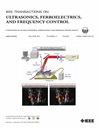Focal Volume, Acoustic Radiation Force, and Strain in Two-Transducer Regimes
IF 3
2区 工程技术
Q1 ACOUSTICS
IEEE transactions on ultrasonics, ferroelectrics, and frequency control
Pub Date : 2024-09-06
DOI:10.1109/TUFFC.2024.3456048
引用次数: 0
Abstract
Transcranial ultrasound stimulation (TUS) holds promise for noninvasive neural modulation in treating neurological disorders. Most clinically relevant targets are deep within the brain (near or at its geometric center), surrounded by other sensitive regions that need to be spared clinical intervention. However, in TUS, increasing frequency with the goal of improving spatial resolution reduces the effective penetration depth. We show that by using a pair of 1-MHz orthogonally arranged transducers, we improve the spatial resolution afforded by each of the transducers individually, by nearly 40 folds, achieving a subcubic millimeter target volume of聚焦体积、声辐射力和双换能器状态下的应变。
经颅聚焦超声刺激(TUS)有望用于治疗神经系统疾病的非侵入性神经调节。大多数与临床相关的目标都位于大脑深部(靠近或位于其几何中心),周围还有其他需要避免临床干预的敏感区域。然而,在 TUS 中,为提高空间分辨率而增加频率会降低有效穿透深度。我们的研究表明,通过使用一对正交排列的 1 MHz 换能器,我们将每个换能器单独提供的空间分辨率提高了近 40 倍,实现了 0.24 mm3 的亚立方毫米目标体积。我们的研究表明,正交放置的换能器会产生高度局部的驻波,其声辐射力(ARF)会在目标附近形成周期性的压缩和拉伸区域。我们进一步介绍了正交设置的扩展功能,即对目标施加选择性压力--正压或负压,但不能同时施加。最后,我们分享了我们的初步研究结果,即粒子运动和 ARF 都会产生应变,前者在焦点处达到最大值,后者在焦点处保持为空,并在焦点周围达到最大值。由于该领域正在通过阐明超声参数与神经反应之间的映射关系来研究 TUS 中的相互作用机制,正交传感器扩展了我们的工具箱,使我们有可能在更精细的空间分辨率下进行这些研究,并具有局部和定向(压缩与拉伸)ARF 以及在目标上施加选择性压力的能力。
本文章由计算机程序翻译,如有差异,请以英文原文为准。
求助全文
约1分钟内获得全文
求助全文
来源期刊
CiteScore
7.70
自引率
16.70%
发文量
583
审稿时长
4.5 months
期刊介绍:
IEEE Transactions on Ultrasonics, Ferroelectrics and Frequency Control includes the theory, technology, materials, and applications relating to: (1) the generation, transmission, and detection of ultrasonic waves and related phenomena; (2) medical ultrasound, including hyperthermia, bioeffects, tissue characterization and imaging; (3) ferroelectric, piezoelectric, and piezomagnetic materials, including crystals, polycrystalline solids, films, polymers, and composites; (4) frequency control, timing and time distribution, including crystal oscillators and other means of classical frequency control, and atomic, molecular and laser frequency control standards. Areas of interest range from fundamental studies to the design and/or applications of devices and systems.

 求助内容:
求助内容: 应助结果提醒方式:
应助结果提醒方式:


